Double-Sided
Issues
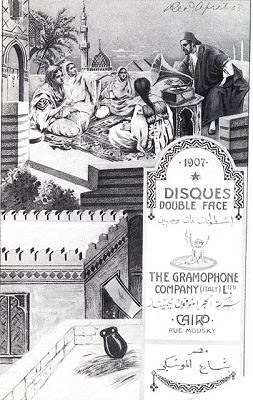
1907
Catalogue of Double-Sided Discs
The International Zonophone Company
was among the first of several record
companies to introduce double-sided
discs. Ademor N. Petit in the United
States appears to have held the first
patent U.S. No. 749,092, applied for
on January 7, 1901 and granted on January
5, 1904. One-half of his patent interests
were assigned to Frederick M. Prescott,
one of the founders and president of
the International Zonophone Company
(see below). One of the earliest double-sided
discs was a coupling of the seven-inch
discs Zonophone 376 and Zonophone 377,
recorded in Berlin in October-November
1901. A large number of both seven-
and ten-inch recordings made in Brussels
in early 1902 were also coupled. The
first Milan seven-inch recordings to
be coupled were in September 1902, after
which only a few seven-inch recordings
made in Paris in early 1903 are found
in double-sided discs. A considerable
number of seven-inch recordings made
in London, Brussels, and Berlin are
known as late as May and June of 1903.
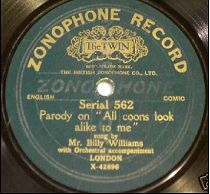
The
TWIN Record Company label, London, March
20, 1909
The
first shipment of 646 ten-inch and 83
twelve-inch double-sided records, presumably
from the manufacturing plant in Berlin,
was made to Fred Figner or Casa Edison,
Rio de Janeiro, Brazil, on May 15, 1902.
These records consisted of blue label
recordings made in Europe, backed with
orange label recordings probably made
in Rio de Janeiro. This would indicate
that the stampers from the Brazilian
recordings had been shipped back to
the Berlin plant. When the Gramophone
Company bought the International Zonophone
Company in Europe, Ch. & J. Ullmann
of Paris had stocks of Zonophone machines
as well as of double-sided records from
the Berlin factory. Further shipments
were discontinued after May 15, 1904.
|
|
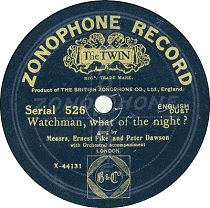 |
|
London,
1907
|
London,
June 1909
|
Authorities differ as to when the Gramophone
& Typewriter Ltd issued its first
double-sided discs. Alan Kelly states
that double-sided black and green label
discs had been issued in both sizes
as early as 1906. John Bennett indicates
that double-sided discs were issued
in September 1907. Frank Andrews, on
the other hand, states that the Gramophone
Company, Ltd. introduced its first double-sided
labeled discs in August 1908. A secondary
department of the company was organised
as The Twin Record Company, which launched
"The Twin Double-Sided Record."
These records were only issued in the
ten-inch size, and sold for slightly
more than single-sided records. During
1910 the Twin Record Company merged
with the British Zonophone Company,
another subsidiary of the Gramophone
Company. The new company began issuing
only double-sided discs under the Zonophone
label, and to issue double-sided 12-inch
discs in May 1911.
|
|
|
|
recorded
in Milan, November-December 1906
|
Labels
on each side of double-sided records
are not always of the same size. Moreover,
when the ring diameter was reduced from
88 to 80 mm, the size of the label remained
at 90 mm. As the outer ring diameter
changed, the overall diameter of the
label was also reduced, leaving a margin
of about 5 mm all around.
|
|
|
|
Recorded
in Paris, May 1906, issued before
19 November 1907
|
Double-sided discs are found with G&T
labels for recordings made before 18
November 1907, and with pre-DOG labels
between that date and February 1909.
Early double-sided discs showed different
catalog numbers for each side, according
to the original single-sided number.
No catalog number was provided for the
double-sided disc itself.
In September 1912 the Gramophone Company
issues 102 twelve-inch ("C"
series) and 55 ten-inch ("B"
series) double-sided discs. All were
Band, Orchestral, or Instrumental recordings,
and all bore plum-colored labels. Bennett
describes this color as violet red.
These series continued throughout the
remainder of the 78 rpm recording era,
replacing the double-sided discs, which
the Gramophone Company had been issuing
since May 1908 through their subsidiary,
the Twin Record Company. The changes
and variations in the designs of the
labels are shown below under section
V. Double Sided Issues.
|
|
|
|
Recorded
in Vienna, 1908, issued before
February 1909
|
In February 1918 two new series were
introduced, the 12-inch "D"
series and the 10-inch "E"
series. These discs bore black labels
on both sides initially, but in March
1924, it was decided to reissue all
extant celebrity recordings from as
far back as 1902, on two new series
of red label discs. These were the HMV
DA and DB series. Of the 20 original
Caruso recordings of 1902, only 12 were
reissued in the first double-sided series.
However, fourteen still appear to be
extant today, the other two being the
"burnt up" shells identified
by Freestone and Drummond, which were
re-recorded in his second recording
session of November 1902.
The recent compilation by Michael Smith
lists 2,112 "D" series and 610 "E" series
discs. HMV D1 was released in February
1918, and E1 was released in July of
that year. The last "D" series was issued
in November 1933, and the last "E" series
was released in October 1930. In addition
to the complete listings, this publication
provides cross references of disc numbers
in manual, automatic, and duplicate
recordings for both series. A listing
is also provided of all of the discs
recorded by each artist, as may be found
in all of Bennett's books.
Many
double-sided discs in the "B", "C",
"D", and "E" series were reissues of
previously or even concurrently issued
single-sided discs. The latter were
issued as late as 1924. At the same
time, most "D" and "E" discs were issued
only as double-sided discs. However,
the practice of assigning single-side
numbers continued as late as 1929. Smith
states HO numbers, referring
to Home Office, as Ho.
However, this is quite incorrect. The
records themselves indicate clearly
that the HO form was always used.
Further variations in the "DOG"
or HMV labels deal mainly with the presence
or absence of quadrants, boxes, company
logos, and different colors in the lower
half of the label. These are described
under Section VIII. The Double-Sided
Issues. The following group of figures
shows most of the label varieties (from
Andrews and Bayly).
|
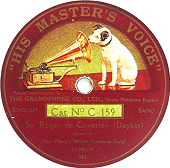
V.A1.a
|
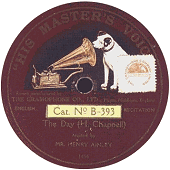
V.A1.b.
|
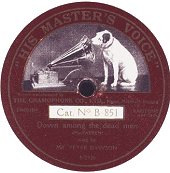
V.A1.4.
|
|
Sep
1912 – May 1913
|
Sep
1919 – Feb 1925
|
Sep
1926 – Oct 1932
|
|
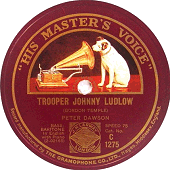
V.A2.9.
|
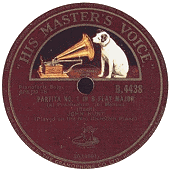
V.A2.12.
|
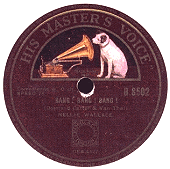
V.A2.13.
|
HMV
B and C Series Labels
From 1912 until at least the end of
June 1924, single-disc numbers were
assigned to each side of most of the
now double-sided discs, although it
is highly unlikely that those single-sided
discs were ever issued again. However,
single-sided discs continued to be issued
throughout the remainder of the acoustical
era. When these were reissued on double-sided
discs, as many of them were, the issuance
of the single-sided version was discontinued.
Bennett lists many of these sides under
single-side numbers. The writer has
checked the original disc labels, or
photographs thereof, of every acoustical
set from the 1917 Mikado through
the 1936 electrical HMV Mikado.
Every side in every set has a single-side
disc number imprinted on the label at
the left.
Left: HMV D 41, a 12-inch double-sided
reissue of the single-sided issues 04693
(shown) and 02830, recorded in June-July
1919.
Center:
HMV D 500, a double-sided reissue
of the single-sided issues 04283 and
04284, recorded in August and May 1920,
respectively.
Right:
HMV D 1172, a 12-inch double-sided
disc electrically recorded September
26, 1926. Note speed shown at lower
right.
The
example of V.A.1.5. on the left
below (see series above) is HMV C
1023, recorded on April 20,
1921. It is unusual, in that it shows
no catalog numbers on either side of
the disc. The assigned single-disc numbers
should have been 05667 and 05668.
Among
the earliest single-side reissues is
John Harrison's "A Wand'ring Minstrel
I," from the 1906 Mikado recording on
HMV 02073, shown above. This was reissued
on HMV D242, the second side being Harrison's
recording of "Thora," by S. Adams. The
earliest single side listed as reissued
on HMV is Edvard Grieg's 1903 recording
of his own "Au Printemps," issued originally
on G&T 35510 and reissued on HMV
D 803. The matrix number 2147F indicates
that the recording was made by Cleveland
Walcutt in Paris on May 2, 1903. This
is not to be confused with matrix number
2147f, which Perkins et al. show to
have been used in 1907 in London.
The Celebrity series were first given
DA and DB letters in August
1924, together with all the old single-sided
numbers. The latter were shortly dropped
from the catalogs. By December of the
same year, the DJ, DK,
DM, DO, DQ, DR, and DS
series had been introduced, again for
pricing purposes. Moreover, these prefixes
were also used to indicate that more
than a single artist appeared. At this
time the principal celebrity label color
was red.
|
|
|
|
IV.b.3.b.
trademark 65 mm. diameter
|
IV.B.3.d.
trademark 50 mm. diameter
|
The
Opera Discs
When
World War I broke out on August 14,
1914, the German government seized the
Gramophone pressing plant in Hanover,
together with over 600 Gramophone and
Victor stampers and other parts in possession
of the Deutsche Grammophon Aktien-Gesellschaft
(DGA). Many of these stampers were used
to press issued discs with labels such
as those shown below.
|
|
|
|
Manufactured
by the Deutsche Grammophon
Aktiengesellschaft
Berlin-Hanover
|
|
November 25, 1908
|
Berlin,
January 15, 1914 |
The
figures above show early Schallplatte
issues, both bearing the phrase "Hergestellt
von der Deutschen Grammophon Aktiengesellschaft,
Berlin-Hanover" above the modified
HMV trademark. Later Schallplatte discs,
as seen below, show the phrase "Hergestellt
von der Deutschen Grammophon Aktiengesellschaft,
Berlin" in an arc above the
trademark, indicating that most of these
discs were manufactured in Berlin. Later
issues used labels with the complete
HMV trademark, as shown below.
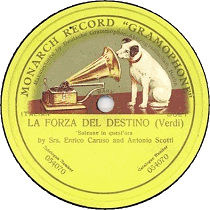
Manufactured
by the Deutsche Berlin, January 15,
1914
Grammophon
Aktiengesellschaft Berlin, Mar 13, 1906
Following World War I, when France and
England were embroiled in legal tangles
regarding German war reparations, The
Gramophone Company of London was not
permitted to use its own name in Germany
nor to sell records using the company’s
trademark "His Master’s Voice,"
as these rights were considered to belong
to the now independent Deutsche Grammophon
Gesellschaft. During the post-World
War I period DGG also issued its own
pressings of the stampers in its possession.
These were single-sided discs bearing
the Schallplatte „Grammophon" or
S.G. label seen above.
During
this post-war period DGG issued its
own pressings of the stampers, single-sided
records bearing the Schallplatte „Grammophon"
or S.G. label seen above, and double-sided
issues with the lower two styles of
labels. These labels bore catalog numbers
of both the Gramophone Company and DGG.
Double-sided
issues under the Künstler Schallplatte,
Grammophon" (K.S.G.) labels are
shown above. These labels bear catalog
numbers of both the Gramophone Company
and DGG. The label style above was used
for twelve-inch issues, while that below
was used for both sizes. Both labels
show engineer’s marking impressed upside
down through the label.
In
March 1917, the German government auctioned
off the various assets of the Gramophone
Company in Germany at the time. Officials
of the newly formed Deutsche Grammophon
Gesellschaft (DGG), not to be confused
with the Deutsche Grammophon Aktien-Gesellschaft
(DGA) formed by William Barry Owen,
licensed the stampers to their own newly
formed subsidiary, Polyphone. These
were in turn licensed to a New York
firm, the Opera Disc Company. In 1920
the latter was soon flooding the United
States with quasi-legal but nevertheless
excellent pressings of these confiscated
recordings.
|
|
|
|
|
|
|
The
so-called Opera Discs
|
|
|
|
|
Recorded
in October 1917, Berlin
|
The
very unusual label on the right above
seems to have been issued in honor or
commemorate the opening night of Leopold
Fall’s Operetta Die Rose von Stamboul,
which had its debut in Vienna on December
2, 1916.
By 1922 it was decided to create two
or more subsidiaries wholly owned by
the Gramophone Company of London. The
German company, named Electrola,
was established in Berlin in 1925 and
would compete in Germany with DGG. A
second company named Gramola
was established in Austria and the newly
established country of Czechoslovakia,
with branch offices in Vienna and Prague,
respectively. A pressing plant was established
in 1926 in Aussig, or Usti nad Leben,
a small town north of Prague, where
Supraphon LP discs are still pressed
today. Neither company could issue DOG
labels so new styles had to be developed;
and these consisted largely of geometric
designs. Records manufactured at the
Aussig plant bore the phrase "Hergestellt
von der Oesterr. Grammophon-Gesellschaft
m. b. H., Aussig a E." above
the trademark.
|
|
|
|
recorded
in Vienna
September 20, 1909
|
Die
Stimmer seines Herrn
above spindle hole
|
|
Post-World
War I Pirate Issues
|
The
label on the left above was printed
in Aussig for a recording made by Leo
Slezak in Vienna on September 20, 1909.
The original HMV label was covered by
the Gramola sticker to permit its sale
in Austria. Note the use of the word
CONCERT in the arc, although
the recording is a 12-inch one. The
label on the right is a 1912 recording
by Caruso that was issued after 1929
by the Deutsche Grammophon Gesellschaft
(DGG), Berlin, with a later form of
the Künstler Schallplatte „Grammophon"
label discussed above. It has been said
that the German companies never translated
"His Master’s Voice" into
German. The label on the right above
belies this allegation, as one finds
the phrase "Die Stimme seines Herrn"
above the spindle hole just inside the
trademark itself.
|
|
|
|
Recorded
April 20, 1914
|
recorded
1927 |
|
|
|
1929
reissue of 1902 recording
|
Victor
Talking Machine Company Labels
There seems to be no reason to present
material here which has been presented
elsewhere in so excellent a format and
coverage. The interested reader is referred
to the works of Michael Sherman, and
of Allen Sutton and Kurt Nauck, cited
below in the Bibliography.